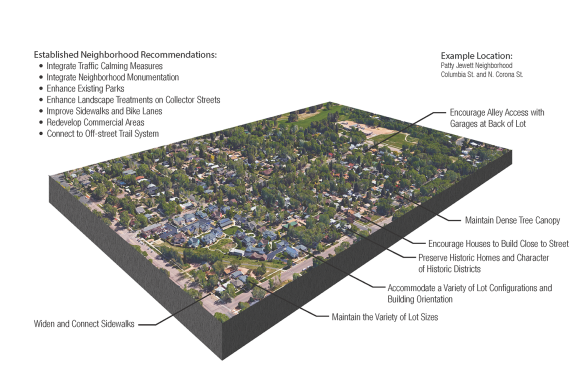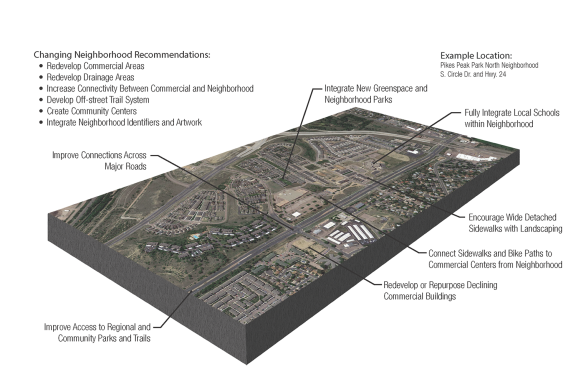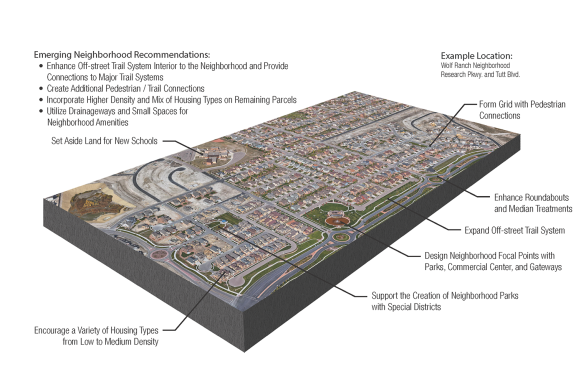Neighborhoods throughout the city have very different characteristics, and are at different stages in development. Therefore, they have differing issues, needs, and priorities. To help address this variety, PlanCOS recognizes several different desired neighborhood typologies to provide a more useful context for City goals and policies. Typologies inform what makes vibrant neighborhoods and suggest enhancements. Achieving these goals will contribute to the prosperity of the city overall. As major projects and changes are proposed, these neighborhood boundaries and typologies should be considered as guidance for discussion and choices about strengthening and supporting neighborhoods. As such, these typologies should be consulted and applied with the understanding that they are examples and therefore need to be considered in context to the surrounding land uses, land use transitions, and overall character.
Some neighborhoods may not fit into a single type because of their individual circumstances and conditions. Planning challenges also result from overlaps in neighborhood typologies that arise from transitions between neighborhoods, or other factors such as varying landscapes (Chapter 7: Majestic Landscapes), multimodal transportation corridors (Chapter 5: Strong Connections), and incorporation of activity centers (Chapter 3: Unique Places). As further described in Chapter 3 and under Typology 2 below, Downtown is considered its own unique type of neighborhood.
Neighborhood typologies are as follows:
- Established Neighborhoods
- Historic Neighborhoods
- Traditional Neighborhoods
- Suburban Neighborhoods
- Changing Neighborhoods
- Emerging Neighborhoods
- Future Neighborhoods
Typology 1: Established Neighborhoods

The goal of this neighborhood typology is to recognize, support, and enhance the existing character of these neighborhoods, while supporting their ongoing investment and improved adaptation. New development and/or redevelopment should incorporate elements of the existing neighborhoods.
Established Neighborhoods are predominantly built-out and have been for at least a few decades. Relative to other neighborhoods, they are stable and do not anticipate high levels of land use changes. However, most Established Neighborhoods within the city should expect some degree of infill and redevelopment. Within this typology, several distinctions are important to the application of PlanCOS, as defined by the following sub-categories:
- Historic Neighborhoods have an especially high value for preserving the legacy of existing design and architecture, although they may have to experience some amount of change especially in areas of transition with less historic uses. These Historic Neighborhoods may or may not have specially adopted City design guidelines or other publicly initiated master plans. These neighborhoods are also closely aligned with Historic Districts in Chapter 6.
- Examples: Old North End, parts of the Westside, and Old Colorado City
- Traditional Neighborhoods, regardless of a formal historic status or relative historic values, are older and developed or at least laid out prior to the mid-1950s. These neighborhoods have a high value in preserving and enhancing walkability features including their gridded street patterns, wide sidewalks, and sometimes limited building setbacks from the street. Some of these areas were developed before zoning was established, or they were annexed following initial development. These established neighborhoods may or may not have adopted publicly initiated master plans, but should eventually have them subject to resources and priority.
- Examples: Knob Hill, Ivywild, and Patty Jewett. Refer to the Framework Map for additional neighborhoods
- Suburban Neighborhoods include those that developed with a suburban pattern, including curvilinear streets with cul-de-sacs. These neighborhoods have matured to the point where they are not actively being developed and no longer have actively managed privately initiated master plans, and ordinarily do not yet have publicly initiated master plans. These neighborhoods have a high value in maintaining the privacy of homes and safe streets for families. New development should focus on safe connections into and within these neighborhoods.
- Examples: Rockrimmon and Springs Ranch. Refer to the Framework Map for additional neighborhoods
Typology 2: Changing Neighborhoods

The goal of this neighborhood typology is to retrofit, reinvent, and introduce new features to enhance the identity, quality, affordability, and attractiveness of these neighborhoods.
Changing Neighborhoods primarily include existing neighborhoods that have the potential or need for City attention, reinvestment, and land use change. Areas of change within these neighborhoods may be focused at the edges (e.g. because of a redeveloping arterial corridor or special area) or be more evenly distributed throughout. Planning emphasis should be placed on implementing strategies necessary to support, incentivize, or adapt to change resulting from market forces, redevelopment, or disinvestment. These neighborhoods will expect to see more infill and redevelopment than other areas of the city.
- Examples: Southeast COS, Valley Hi, and Park Hill. Refer to the Framework Map for additional neighborhoods
- Downtown, and specifically Southwest Downtown, is a subcategory of this typology. Redevelopment here could be transformative due to the potential for extremely high densities.
Typology 3: Emerging Neighborhoods

The goal of this neighborhood typology is to ensure the further application of amenities and best practices within these neighborhoods in order to enhance their livability and adaptability as they mature.
Emerging Neighborhoods are found in newer areas of the city, now farthest from Downtown. Actively managed, privately initiated master plans typically guide their initial development and can be refined and updated for not-yet-developed properties. Such adaptations are a focus of this Plan, as development in these neighborhoods should consider the impact that proposed development has on existing infrastructure and neighborhoods. Parts of these neighborhoods with recently completed construction are assumed relatively stable, and less vulnerable to near- and mid-term change. In most cases, these Emerging Neighborhoods are located in and served by special districts that are used to finance public improvements and to provide higher levels of ongoing services and amenities.
- Examples: Generally, neighborhoods in the north and east, Wolf Ranch, and Woodmen Heights. Refer to the Framework Map for additional neighborhoods.
Typology 4: Future Neighborhoods

The goal of this neighborhood typology is to include those desired elements that result in great neighborhood design as each new neighborhood emerges over the next 20 years.
Future Neighborhoods are those that have yet to be developed in the city, most notably within Banning Lewis Ranch. These areas provide an opportunity to create, from the ground up, new, diverse, and “smart” connected neighborhoods that reflect the PlanCOS Vibrant Neighborhoods vision and goals, while addressing emerging demographic and market considerations. These neighborhoods should consider the impact their development has on existing infrastructure and neighborhoods. For the most part, they are expected to be actively guided by privately initiated master plans or other guiding documents such as Planned Unit Development plans or holistic concept plans. These newly developed or amended documents should be prepared and adopted with consideration of this Plan.
